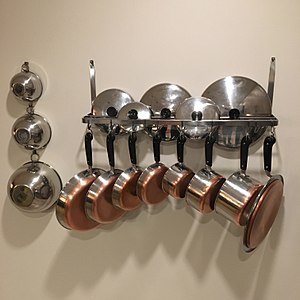
Revere Ware was a line of consumer and commercial kitchen wares introduced in 1939 by the Revere Brass & Copper Corp. The line focuses primarily on consumer cookware such as (but not limited to) skillets, sauce pans, stock pots, and tea kettles. Initially Revere Ware was the culmination of various innovative techniques developed during the 1930s, the most popular being construction of stainless steel with rivetlessly attached bakelite handles, copper-clad bases and rounded interiors for ease of cleaning. Over the next 40+ years, Revere Ware would introduce new series to position itself in competition with other manufacturers at various price points, or for specific specialty markets.[1] In the early 1960s the profitability of Revere Ware began to level off. Coinciding with new series introductions, cost-cutting measures were implemented in the manufacture of the traditional cookware. The bakelite handles were changed from two piece to one, and the thickness of utensil walls and copper cladding were reduced.[2]
While the cookware division remained profitable, the seventies saw parent company Revere Brass & Copper Corp. experience a shift of fortune. Transferring of its aluminum production from domestic to overseas manufacturing marked the beginning of the end.[3] By 1982 financial issues due to these failing aluminum operations forced Revere Brass & Copper to file for bankruptcy.[4] By 1985 the cookware subsidiary Revere Ware Incorporated, which had remained profitable, had been sold to Corning Glass Inc. Within ten years Corning Glass Inc. had expanded Revere Ware from the four lines at their acquisition, to over a dozen lines, while ceasing any domestic manufacturing. In 1998 World Kitchen became the controlling parent company of Corning. During this period Revere Ware suffered from branding incoherency, with nearly a dozen new "lines" introduced by 2006 before briefly leaving the market. Revere Ware has since been reintroduced, as World Kitchen currently (as of 2016) offers select variations: Copper-cored stainless steel, traditional copper-clad bottomed cookware and anodized non-stick aluminum.
- Note: As of 2018, World Kitchen has ceased operations and the Revere Ware (https://www.revereware.com/) line is no longer in production.[5]
- ^ "History of Revere Copper and Brass". Revereware.org. Archived from the original on 1 February 2015. Retrieved October 23, 2016.
- ^ "The Evolution of Revere Ware (1932–1949)". reverewarehistory.wordpress.com. 25 March 2012. Archived from the original on 24 October 2016. Retrieved October 24, 2016.
- ^ "Expansion in the 1960s and 1970s". fundinguniversity.com. Retrieved October 23, 2016.
- ^ Cole, Robert J. (28 October 1982). "Revere Files Petition for Chapter 11". The New York Times.
- ^ "Reorganization in the 1980s". fundinguniversity.com. Retrieved October 23, 2016.